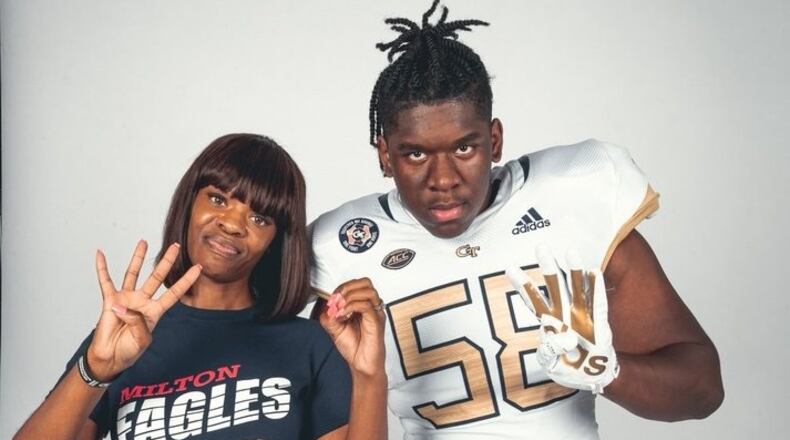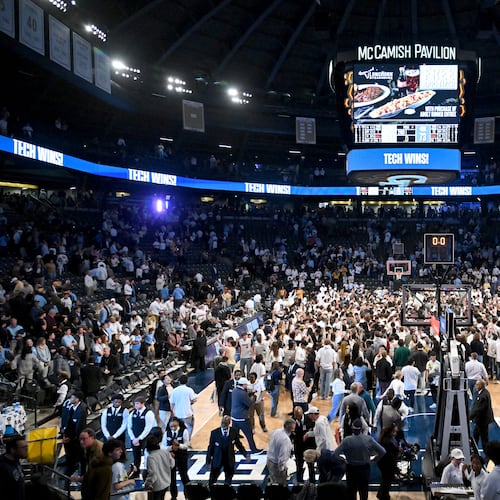As he pushed himself through drills with a potential scholarship offer on the table, Milton High offensive lineman Brandon Best was looking for some kind of feedback as to how he was doing. But, Georgia Tech offensive-line coach Brent Key was offering none, only directing Best through the hour-long workout.
“I was honestly kind of wondering (what Key was thinking),” Best said. “You never really know.”
After completing the workout at Bobby Dodd Stadium on June 1, the first day that in-person recruiting was permitted since March 2020, Best got a tour of the facilities before meeting up again with Key, who thrilled the rising senior and his mother, Sharee, with a scholarship offer.
“It made me extremely happy and, obviously, just the thought of being able to play at home, that’s been huge for me personally,” Best said.
The workout under the eyes of Key is a new element of the recruiting process, one that may be gone after the summer. Before the reopening of in-person recruiting in June, the NCAA granted a waiver that allowed football coaches to conduct individual on-campus workouts for members of the 2021 and 2022 recruiting classes, including junior-college players and transfer candidates. Without the waiver, college coaches could work hands-on with prospects only in camps.
It was a way to compensate for the lack of in-person evaluating that college teams had been unable to do, namely at the camps, since March 2020 because of the NCAA’s restrictions on in-person recruiting because of COVID-19.
Tech coach Geoff Collins and his staff made heavy use of the waiver, bringing in dozens of prospects for individual workouts throughout the month of June. While it’s not clear if the waiver will become an NCAA bylaw – on-campus evaluations are permitted in basketball, although only after the prospect’s high-school or junior-college career is complete, or a transfer candidate’s season is over – Tech has appreciated its availability.
“It’s definitely been a good tool to use,” Tech general manager Patrick Suddes told the AJC.
Best, who attended Tucker High for three years before transferring to Milton, could attest. He announced his commitment to Tech on June 21, selecting the Yellow Jackets over Kansas State.
“I think it’s a perfect medium because, obviously, the athlete gets a chance to actually work out and show what they have to offer, and the coaches get a chance to evaluate in a smaller setting,” Best said.
Best said that after he received a scholarship offer from Virginia Tech in May and posted it on Twitter, “a bunch of coaches” from the ACC began following him on the social-media platform to reach out to him. Best doesn’t remember when Key followed Best, but during that time Best messaged Key, who responded with an invitation to visit Tech for a camp or another unofficial visit. (It likely helped that as Best transitioned from one school to another, he had former All-Pro offensive lineman Willie Anderson, who runs a training academy for linemen, vouching for him.) When Best set up a visit and then received a request for a physical the day before he was to come, Best knew he was going to be worked out.
The workout itself was nothing out of the ordinary, Best said, with Key directing him through standard offensive-line drills with the help of graduate assistant Brenten Wimberly.
“A lot of movement stuff – opening your hips coming off the ball, driving your hips, stuff like that,” Best said.
Another Tech recruit who went through an individual workout, Hapeville Charter High senior cornerback Quantaves “Gumbo” Gaskins, described it similarly.
“The standard change of direction, ball and explosion drills,” Gaskins wrote in a Twitter direct message. “Many of the drills you would see in a pro combine.”
Neither admitted to being especially nervous, even though they were the only participant in the workout with stakes nothing less than a scholarship offer.
“I wasn’t nervous,” Best said. “I was just ready to come work out.”
Perhaps it’s not a coincidence that Best and Gaskins were two of only a handful of prospects to earn scholarship offers after their workouts at Tech.
“My mindset was to show I’m one of the best under-the-radar DBs in the country,” wrote Gaskins, who also collected offers from the likes of Missouri, Vanderbilt, South Carolina, Kansas State and Nebraska (along with Tech) during a June full of visits and workouts.
Tech tested prospects at a variety of positions. NCAA rules restrict the workouts to one hour, with other limitations such as only coaches and graduate assistants being able to conduct the sessions. Equipment such as footballs and cones are permitted, blocking sleds are not. Players are not to wear any protective gear such as a helmet or pads. Best did his in a T-shirt, shorts and cleats.
Gaskins, whose workout was led by cornerbacks coach Jeff Popovich, called it fun, exhausting and challenging.
“I expect to be tested and challenged to see if I’m built for the rigor,” Gaskins wrote. “But I make it fun because this is what I want to do and dominate.”
The waiver will be available to teams through the end of July. While a time-intensive exercise for coaches that has limitations – as they’re one-player workouts, a wide receiver would have to have a coach or GA throw to him and can’t compete against coverage, for instance – there is some hope for it to continue, as it’s a way for a prospect to get a more thorough evaluation than at a camp, where there can be hundreds of prospects and the atmosphere can be chaotic.
“A lot of those camps, there’s so many kids there, you may not get as noticed or as much one-on-one time, and anytime a kid’s going to invest their resources and their time, travel out of town, across the state, I think it’s a good thing they can get a one-on-one (evaluation),” Alpharetta High coach Jason Kervin said. “That way, the kid knows they at least get a legit opportunity to be seen. Absolutely, I think it’s a great thing.”
About the Author
Keep Reading
The Latest
Featured



